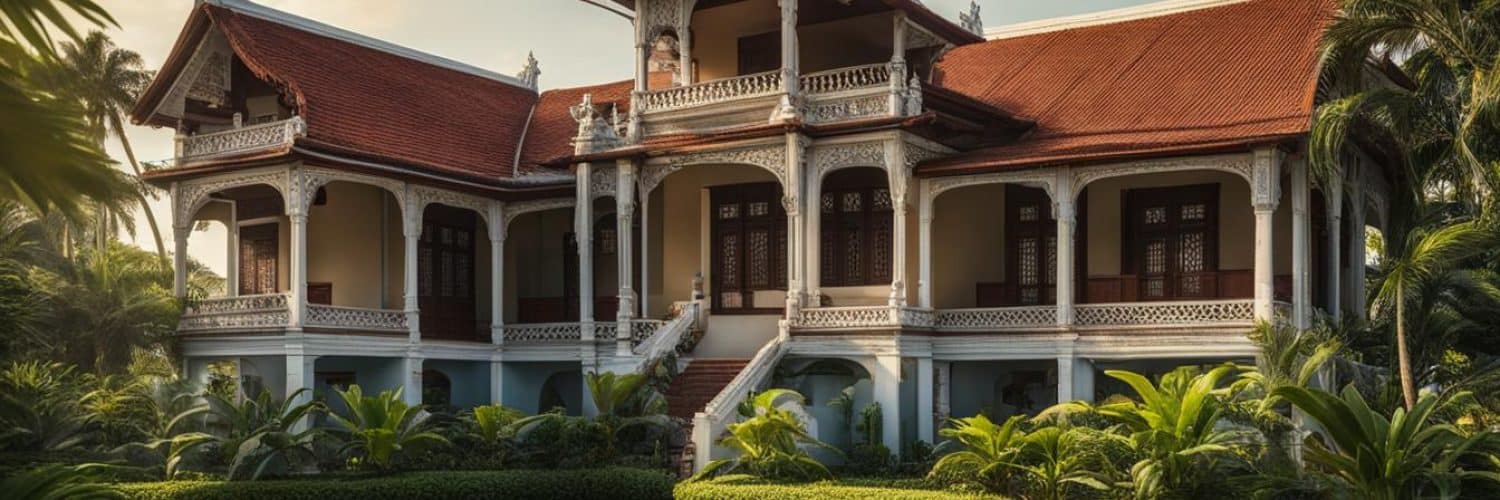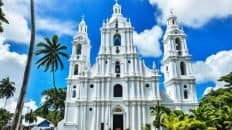Welcome to Silay City, Negros Occidental, where history comes to life at Balay Negrense, a charming heritage house that takes visitors on a journey back in time. This well-preserved architectural gem offers a glimpse into the opulent lifestyle of the sugar barons who once reigned supreme in this region.
Built in the early 20th century, Balay Negrense showcases the distinctive “bahay na bato” style, a fusion of Filipino and Spanish architectural elements. As you step through its doors, you’ll find yourself immersed in the rich history and cultural heritage of Negros Occidental.
More than just a museum, Balay Negrense is a cultural center that hosts art exhibits, cultural events, and educational programs. It stands as a testament to the grandeur of the past and serves as a must-visit tourist attraction in Silay City and one of the Philippine heritage sites.
Key Takeaways:
- Balay Negrense is a well-preserved heritage house in Silay City, Negros Occidental.
- It showcases the distinctive “bahay na bato” style and offers a glimpse into the opulent lifestyle of the sugar barons.
- Balay Negrense is not only a museum but also a cultural center that hosts various events and programs.
- It is a significant tourist attraction in Silay City and one of the Philippine heritage sites.
- Visiting Balay Negrense allows you to step back in time and experience the rich history and cultural heritage of Negros Occidental.
Balay Negrense – A Window into Negrense Culture
Balay Negrense, once the residence of Victor F. Gaston, a prominent sugar baron, is a significant symbol of Negrense culture and history. As one of the well-maintained heritage houses in Silay City, it offers visitors a comprehensive experience of life during the sugar boom era in Negros Occidental. The mansion’s colonial architecture and antique-filled rooms provide a glimpse into the opulence and grandeur of the past, showcasing the region’s cultural heritage.
Victor F. Gaston, a renowned sugar baron during the sugar boom era, called Balay Negrense his home. This magnificent heritage house serves as a window into Negrense culture, offering visitors a vivid portrayal of the opulent lifestyle that characterized the region. The architectural beauty of Balay Negrense transports guests to a bygone era, allowing them to immerse themselves in the heritage and history of Negros Occidental.
The Opulent Residence of Victor F. Gaston
Balay Negrense stands as a testament to the grandeur and influence of Victor F. Gaston, a prominent figure in the sugar industry during the sugar boom era in Silay City. The mansion showcases the architectural brilliance of the time and serves as a cultural icon that highlights Negrense heritage and identity.
A Glimpse into the Sugar Boom Era
Step inside Balay Negrense and journey back in time to the period when Negros Occidental experienced an economic boom fueled by the sugar industry. The mansion’s meticulously preserved rooms, elegant interiors, and antique furnishings offer a fascinating insight into the extravagant lifestyle enjoyed by sugar barons and their families.
Silay City: The Epitome of Negrense Culture
Silay City, renowned for its well-preserved heritage houses, including Balay Negrense, stands as a living testament to the region’s rich cultural heritage. These architectural gems, scattered throughout the city, serve as a reminder of the sugar boom era and the integral role it played in shaping Negrense identity.
| Keyword | Description |
|---|---|
| Negrense culture | The unique culture and traditions of the people of Negros Occidental. |
| Victor F. Gaston | A prominent sugar baron during the sugar boom era in Silay City. |
| Sugar baron | A wealthy individual who owned and operated sugar plantations during the sugar boom era. |
| Sugar boom era | A period of economic growth and prosperity in Negros Occidental driven by the sugar industry. |
| Silay City | A city in Negros Occidental known for its heritage houses and rich cultural heritage. |
The Silay Heritage Houses – A Collective Legacy
Silay City, often referred to as the “Paris of Negros,” is home to several well-preserved heritage houses known as the Silay Heritage Houses. These houses collectively embody the city’s cultural heritage and serve as a testament to its rich history. The Bernardino-Jalandoni House, Hofileña Ancestral House, and Balay Negrense are just a few examples of the architectural gems that showcase Negrense history and the illustrious sugar industry that thrived in the region.
Nestled in Silay City, Negros Occidental, the Silay Heritage Houses stand as a proud testament to the city’s vibrant past. These historic homes have been meticulously preserved, offering visitors a glimpse into the grandeur and elegance of a bygone era. Each house tells a unique story, representing the legacy of Negros Occidental’s sugar boom and the Negrense people who called these houses home.
One of the iconic heritage houses in Silay City is the Bernardino-Jalandoni House. This magnificent structure showcases a fusion of Filipino, Spanish, and American architectural influences, reflecting the rich cultural tapestry of the region. With its ornate detailing and grandeur, the Bernardino-Jalandoni House captures the imagination and transports visitors to a time of opulence and sophistication.
Another remarkable heritage house in Silay is the Hofileña Ancestral House. This architectural gem is renowned for its distinctive Art Deco design, which beautifully blends European elegance with local craftsmanship. Step inside and be captivated by the intricate carvings, vintage furniture, and timeless charm that exude the spirit of the past.
No visit to Silay City would be complete without exploring Balay Negrense, the crown jewel of the Silay Heritage Houses. This iconic mansion, built by Victor F. Gaston, a prominent sugar baron, perfectly encapsulates the grandeur and splendor of Negrense history. Immerse yourself in the breathtaking beauty of the house’s colonial architecture, marvel at the antique-filled rooms, and imagine the vibrant lifestyle of the sugar barons who once inhabited this opulent residence.
The Silay Heritage Houses stand as a collective legacy, representing the rich cultural heritage and Negrense history. These architectural treasures are a testament to the region’s past and serve as a source of inspiration and pride for the community. Visitors to Silay City can immerse themselves in the stories of the past, experiencing firsthand the charm and elegance of these well-preserved heritage homes.
The Heritage Houses of Vigan – A Glimpse of Spanish Influence
In the city of Vigan, located in the northern Philippines, visitors can explore a collection of well-preserved heritage houses that transport them back to the Spanish colonial period. With its cobblestone streets, ancestral houses, and horse-drawn carriages, Vigan exudes a sense of nostalgia and showcases the strong Spanish influence in Filipino culture.
The heritage houses of Vigan stand as testament to the city’s rich history and architectural legacy. From grand mansions to charming ancestral homes, each structure showcases the unique blend of Filipino-Spanish architecture that flourished during the colonial era.
| Heritage House | Architectural Style |
|---|---|
| Syquia Mansion | Bahay na Bato |
| Crisologo Museum | Spanish Colonial |
| Burgos National Museum | Filipino-Spanish |
These heritage houses not only charm visitors with their captivating facades but also provide a glimpse into the opulent lifestyles of past residents. Each house is adorned with intricate details, from ornate balconies to hand-carved wooden accents, reminiscent of a bygone era.
Vigan is a living testament to the rich cultural heritage of the Philippines. Its heritage houses serve as tangible links to our colonial past, allowing visitors to immerse themselves in the history and architectural beauty of the Spanish colonial era.
Exploring these heritage houses is like stepping into a time machine, as visitors are transported back to a period of grandeur and elegance. The cobblestone streets and preserved architecture create a romantic ambiance that captivates both locals and tourists alike.
Preserving Vigan’s Cultural Legacy
Vigan’s heritage houses are more than just architectural marvels—they represent the cultural identity of the city and its people. Efforts to preserve and protect these historical gems have been recognized, with Vigan being declared a UNESCO World Heritage Site in 1999.
This prestigious recognition has not only boosted tourism in the region but has also ensured the continued maintenance and restoration of Vigan’s heritage houses for future generations to appreciate and enjoy.
- Vigan offers a unique perspective on the Spanish colonial period in the Philippines.
- The heritage houses provide a glimpse into the lives of the influential families who shaped Vigan’s history.
- The architecture showcases a harmonious blend of Spanish, Chinese, and Filipino influences.
- Vigan’s cobblestone streets and vibrant heritage houses have become iconic symbols of the city.
Whether marveling at the intricate details of the Syquia Mansion, exploring the historical artifacts at the Crisologo Museum, or strolling along the streets lined with ancestral houses, a visit to Vigan’s heritage houses is a journey through time and a celebration of the enduring Spanish influence in Filipino culture.
The Taal Heritage Town – A Taste of Old Philippines
Taal, a picturesque town nestled in Batangas, is a true gem when it comes to architectural heritage. Known as the “Heritage Town of the Philippines,” Taal boasts an impressive collection of well-preserved ancestral houses that showcase the charming Filipino-Spanish architecture of bygone eras. These ancestral homes serve as a testament to the town’s rich history and offer visitors a delightful taste of the old Philippines.
One of the notable ancestral houses in Taal is the Goco Ancestral House. Built in the 1870s, this architectural marvel stands as a testament to the elegant designs influenced by both Filipino and Spanish cultures. The intricate details, large windows, and grandiose rooms transport visitors back in time, allowing them to experience the opulence of the past.
A visit to Taal would not be complete without exploring the Villavicencio Wedding Gift House. Originally constructed in 1872 as a wedding gift, this house showcases the grandeur of Spanish-era architecture blended with traditional Filipino elements. The intricate ironworks, colorful stained glass windows, and antique furniture offer a glimpse into the rich heritage of the town.
The Casa Villavicencio, another prominent ancestral house, highlights the town’s architectural treasures. This well-preserved heritage home, built in the 1850s, is characterized by its striking facade and charming interiors, epitomizing the elegance of Filipino-Spanish architecture. Stepping inside this ancestral house is like stepping into a time capsule, immersing oneself in the beauty of the past.
| Ancestral House | Year Built | Architectural Style |
|---|---|---|
| Goco Ancestral House | 1870s | Filipino-Spanish |
| Villavicencio Wedding Gift House | 1872 | Filipino-Spanish with Traditional Filipino Elements |
| Casa Villavicencio | 1850s | Filipino-Spanish |
Visiting the Taal Heritage Town is a delightful journey into the past, offering a glimpse of the architectural splendor and cultural richness that once defined the old Philippines. The town’s ancestral houses provide a window into history, showcasing the harmonious fusion of Filipino and Spanish influences that shaped the unique heritage of Taal.
Balay Negrense – Architectural Highlights
Balay Negrense, a historic gem in Silay City, showcases architectural highlights that captivate visitors. This well-preserved heritage house is a testament to the opulent lifestyle of the sugar barons and an embodiment of the American colonial architecture and bahay na bato design.
The exterior of Balay Negrense boasts a graceful and airy structure that reflects the elegance and functionality of American colonial architecture in the Philippines. Its wide verandas provide a perfect spot to enjoy the tropical breeze, while the louvered windows allow for natural ventilation and a picturesque view of the surroundings. The steep-pitched roof adds a touch of charm and character to the house, complementing its overall architectural design.
Silay Heritage Houses – A Cluster of Architectural Styles
The Silay Heritage Houses in Silay City, Negros Occidental, are a delightful collection of well-preserved heritage homes that showcase a blend of architectural styles. Each house tells a unique story, reflecting the influences of different eras and cultural elements.
The Bernardino-Jalandoni House: Italianate Architecture
The Bernardino-Jalandoni House stands out with its exquisite Italianate architecture, characterized by its ornate detailing and intricate design elements. This magnificent mansion is a testament to the grandeur and elegance of the Italian Renaissance, transporting visitors to a bygone era of opulence and sophistication.
The Hofileña Ancestral House: Filipino-Spanish Fusion
The Hofileña Ancestral House is a remarkable example of Filipino-Spanish architectural fusion. This house seamlessly combines Filipino design elements with Spanish influences, creating a unique and captivating atmosphere. Visitors can admire the beautiful wooden carvings, intricate ironwork, and traditional Filipino craftsmanship that adorn this charming ancestral home.
Balay Negrense: Embracing American Colonial Style
Balay Negrense, one of the most prominent Silay Heritage Houses, epitomizes the American colonial style. With its wide verandas, louvered windows, and steep-pitched roof, this architectural gem showcases the elegance and functionality characteristic of American colonial architecture in the Philippines. Inside, visitors will find themselves surrounded by period pieces and antique heirlooms, immersed in the lavish lifestyle of the sugar barons.
These Silay Heritage Houses collectively create a diverse architectural landscape, offering visitors a captivating journey through various styles and historical periods. From the Italianate beauty of the Bernardino-Jalandoni House to the Filipino-Spanish fusion of the Hofileña Ancestral House, and the American colonial grandeur of Balay Negrense, these architectural treasures are a testament to Silay City’s rich cultural heritage.
Vigan Heritage Houses – Spanish Colonial Splendor
The heritage houses in Vigan exude the splendor of Spanish colonial architecture. These bahay na bato structures feature thick walls, high ceilings, and red-tiled roofs, showcasing the grandeur and sophistication of the era. Among the notable heritage houses in Vigan is the Syquia Mansion, which exemplifies the rich history and architectural beauty of the city.
Architectural Marvels of Vigan
Vigan’s heritage houses, crafted with meticulous attention to detail, serve as reminders of the city’s rich past and cultural heritage. The fusion of Spanish colonial influences with Filipino craftsmanship results in breathtaking structures that transport visitors to a bygone era.
“The heritage houses in Vigan stand as testaments to the glorious Spanish colonial era in the Philippines. With their harmonious blend of Asian and European architectural styles, they are notable cultural treasures worth exploring and preserving.” – Architect Carlos Villanueva
Distinctive Features
Vigan’s heritage houses are renowned for their distinctive features that embody the elegance and sophistication of Spanish colonial architecture. These include:
- Thick walls: The solid and durable construction provides insulation against the tropical climate.
- High ceilings: The lofty interiors enhance air circulation and create a sense of spaciousness.
- Bahay na bato design: The combination of stone lower walls and wooden upper floors exudes charm and authenticity.
- Red-tiled roofs: The vibrant red tiles add a touch of vibrancy and character to the structures.
A Glimpse into the Past
As you stroll along the centuries-old cobblestone streets of Vigan, the heritage houses beckon you to relive history. Step inside these architectural marvels, and you’ll discover a treasure trove of antique furniture, art pieces, and heirlooms that chronicle the glorious past of the city.
Whether you’re an architecture enthusiast, a history buff, or simply someone seeking to immerse yourself in the beauty of the past, Vigan’s heritage houses offer an unforgettable journey into the Spanish colonial era. Take a leisurely stroll and admire the architectural splendor that has earned Vigan a spot on the prestigious list of UNESCO World Heritage Sites.
Balay Negrense – Historical Significance
Balay Negrense is more than just a beautiful heritage house; it holds significant historical value as a witness to the Negros sugar boom during the American colonial period. This architectural masterpiece offers a tangible connection to the opulent lifestyle of Negrense sugar barons of the past, providing a fascinating glimpse into their lavish lives.
During the American colonial period, Negros Occidental experienced a sugar boom, becoming the sugar bowl of the Philippines. Balay Negrense stands as a testament to this prosperous era, showcasing the grandeur and wealth that fueled the region’s growth. As visitors explore its rooms and corridors, they can immerse themselves in the captivating history of this iconic period.
Preserving Heritage and History
Recognizing the importance of Balay Negrense in preserving regional history, efforts have been made to transform this heritage house into a museum. Today, it serves as a cultural hub, not only preserving the physical structure but also showcasing the stories and legacy of the people who once called it home.
“Balay Negrense allows us to step back in time and experience the grandeur of the Negrense sugar barons. It serves as a reminder of the vibrant history and cultural heritage of Negros Occidental.” – Local historian
By opening its doors to the public, Balay Negrense allows visitors to appreciate and understand the significance of the American colonial period and its impact on the region. Through curated exhibits and educational programs, it contributes to the preservation and promotion of Negrense history and culture.
A Window into the Past
Exploring Balay Negrense gives visitors a unique opportunity to walk through the rooms that were once filled with laughter, music, and opulence. From the intricate architectural details to the exquisite selection of antique furniture, each corner of this heritage house reflects the rich heritage of Negros Occidental and the influential sugar industry that shaped the region.
Today, Balay Negrense stands as a symbol of heritage preservation, allowing present generations to learn from the past and appreciate the legacy left behind by the Negrense sugar barons. By exploring this architectural gem, visitors can gain a deeper understanding of the history, culture, and lifestyle of Negros Occidental during the American colonial period.
Conclusion
Heritage homes like Balay Negrense, the Silay Heritage Houses, Vigan’s heritage homes, and the ancestral houses in Taal are not merely tourist attractions, but invaluable national treasures that proudly showcase the rich history and cultural identity of the Philippines. These architectural gems stand as testament to the opulence and grandeur of bygone eras, offering visitors a glimpse into the lives and legacies of the past.
Cultural preservation is of utmost importance in safeguarding these heritage homes, ensuring that future generations can appreciate and learn from their historical significance. By preserving these architectural wonders, we preserve a part of our collective heritage, telling the stories of our ancestors and their contributions to our nation’s development.
These national treasures also play a pivotal role in the growth of Philippine tourism. They captivate visitors from all over the world, drawing them in with their unique charm and cultural richness. The preservation and promotion of these heritage homes not only help boost local economies but also create opportunities for cultural exchange and understanding.
In conclusion, the significance of heritage homes cannot be overstated. They serve as tangible links to our past and exemplify the importance of cultural preservation. As we continue to celebrate and promote these national treasures, we pave the way for a more sustainable and vibrant Philippine tourism industry, allowing our heritage to shine for generations to come.
FAQ
What is Balay Negrense?
Balay Negrense is a well-preserved heritage house located in Silay City, Negros Occidental. It offers visitors a glimpse into the region’s rich history and cultural heritage.
When was Balay Negrense built?
Balay Negrense was built in the early 20th century.
What architectural style does Balay Negrense showcase?
Balay Negrense showcases the distinct “bahay na bato” style, which was prevalent during the early 20th century.
What can visitors experience at Balay Negrense?
Visitors can experience the opulent lifestyle of the sugar barons, as well as explore art exhibits, cultural events, and educational programs at Balay Negrense.
Who used to reside in Balay Negrense?
Balay Negrense was once the residence of Victor F. Gaston, a prominent sugar baron.
What is Silay City known for?
Silay City, often referred to as the “Paris of Negros,” is known for its well-preserved heritage houses, including the Silay Heritage Houses.
What are the Silay Heritage Houses?
The Silay Heritage Houses are a collection of well-preserved heritage houses in Silay City that collectively embody the city’s cultural heritage and serve as a testament to its rich history.
What architectural styles can be found in Silay City?
The Silay Heritage Houses showcase various architectural styles, including Italianate architecture, Filipino-Spanish elements, and American colonial style.
What is Vigan known for?
Vigan is known for its well-preserved heritage houses that transport visitors back to the Spanish colonial period. It is often referred to as the “Heritage Town of the Philippines.”
What architectural features can be found in Vigan’s heritage houses?
Vigan’s heritage houses feature bahay na bato structures with stone lower walls, wood upper floors, thick walls, high ceilings, and red-tiled roofs.
Why is Balay Negrense historically significant?
Balay Negrense holds historical significance as it provides a tangible connection to the Negros sugar boom and the opulent lifestyle of Negrense sugar barons during the American colonial period.

















Add comment